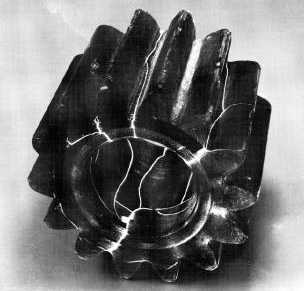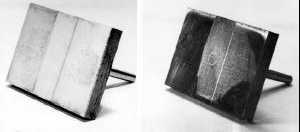T.O. 33B-1-1
3-93
c. Any discontinuity that occurs in an area of high stress must be more carefully considered than a
discontinuity of the same size and shape in an area where the stress is low.
d. Discontinuities that are sharp, such as grinding cracks or fatigue cracks are severe stress raisers and are
more harmful in any location than rounded discontinuities such as scratches.
e. Any discontinuity that occurs in a location close to a keyway or fillet must be considered to be more
harmful than a discontinuity of the same size and shape which occurs away from such a location.
3.7.3.3.3
Magnetic Discontinuities.
Magnetic discontinuities in the part under examination will produce indications. These discontinuities may not always
be associated with physical discontinuities. Magnetic discontinuities may be caused by:
a. An actual physical discontinuity at or near the surface of a part, which may have been present in the
original metal, or may have been produced by subsequent forming, heating, or finishing processes or
service use. (See Figure 3-44)
Figure 3-44. Typical Magnetic Particle Indications of Cracks
b. Actual physical discontinuities which are, however, present by design, as for example, an interference
or close fit between two members of an assembly. Figure 3-45 illustrates this condition.
Figure 3-45. Magnetic Particle Indication of a Forced Fit
c. A weld between two dissimilar ferromagnetic metals having different permeabilities; or between a
ferromagnetic metal and a non-magnetic material. Indications may be produced at such a point even



